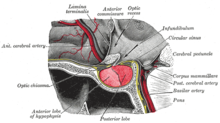Adenohypophysis
The adenohypophysis (Greek- Latin : adenohypophysis ) is the glandular ( endocrine ) and larger part of the pituitary gland ( pituitary gland ) located at the base of the brain and consists of the anterior pituitary lobe and the pituitary middle lobe or intermediate lobe of the pituitary gland . “Adenohypophysis” is often used synonymously with “anterior pituitary lobe”. The adenohypophysis, controlled by hormones of the hypothalamus , produces growth hormone and other glands (thyroid, gonads, adrenal cortex) controlling hormones. In terms of evolution, it emerges from the Rathke pocket in the oral cavity and is therefore often not considered to be part of the brain, in contrast to the neurohypophysis . While the anterior pituitary lobe in humans (and even ungulates ) represents the anterior part of the pituitary gland, in some mammals (e.g. predators and horses ) it completely surrounds the neurohypophysis (posterior pituitary lobe).
construction
The structure of the adenohypophysis is typical of an endocrine gland . Numerous hormones are formed here that act as effector or control hormones . The hormone production of the adenohypophysis itself is in turn controlled by releasing hormones ( liberins ) and inhibiting hormones ( statins ) of the hypothalamus and, as a rule, by the regulated peripheral hormones.
The adenohypophysis has three parts:
- The anterior lobe (the pars distalis ) is the anterior part of the pituitary gland. It contains acidophilic alpha, basophilic beta, chromophobic gamma and acidophilic eta cells (= pregnancy cells).
- The intermediate lobe (the pars intermedia ) is located between the anterior and posterior lobes (part of the neurohypophysis). Melanocyte-stimulating hormone (MSH) is produced in its cells .
- The funnel flap (the pars tuberalis ) surrounds the pituitary stalk (part of the neurohypophysis) from the front. So far nothing is known about its function.
Glandotropic hormones
Glandotrope ("acting on glands", from Latin glandula "gland") hormones are control hormones of the anterior pituitary gland, which regulate the hormone production of other endocrine organs :
- TSH (thyroid stimulating hormone), or thyrotropin, stimulates the thyroid gland (glandula thyroidea).
- ACTH (adrenocorticotropic hormone), stimulates the adrenal cortex .
- FSH (Follicle Stimulating Hormone), stimulates the gonads .
- LH (Luteinizing Hormone), stimulates the gonads.
The latter two hormones are also grouped together as gonadotropins .
Non-Englandotropic hormones
Effector hormones that do not act on the endocrine glands, but directly on the successor organs, are:
- the growth hormone STH (somatotropic hormone) or somatotropin
- PRL ( prolactin ) or lactotropic hormone (LTH)
- MSH (melanocyte-stimulating hormone) or melanotropin (also called melanophore hormone and intermedin), which is produced in the middle lobe of the pituitary gland
Cell types
Using a light microscope , three cell types can be distinguished through different staining behavior in the adenohypophysis. These are acidophilic, basophilic and chromophobic cells.
Acidophilic cells
These acid-stainable cells ( acidophilic cells ) are most common in the adenohypophysis. Granules in the cytoplasm that can be colored red are particularly characteristic . They only form non-Englandotropic hormones and can be divided into two subgroups:
- Lactotropic cells produce prolactin. This cell type makes up 20% of the cells of the adenohypophysis. In men they are less common than in women, in whom they can make up up to 70% of the cells during pregnancy . Relatively large secretion granules with an irregular shape are typical of lactotropic cells.
- Somatotropic cells produce the somatotropic hormone (STH). Their proportion in the cells of the adenohypophysis is approx. 50% and decreases with age. Their granules are smaller.
Basophil cells
Because of the secretion granules enclosed in the cytoplasm, this cell type can be stained dark purple-blue with basophilic dyes. Here, too, different cell types can be distinguished depending on the hormone production, with all except the MSH-producing cells forming glandotropic hormones:
- Gonadotropic cells produce the hormones FSH and LH, which act on the gonads . These cells are relatively large and make up about 10% of all adenohypophyseal cells.
- Thyroid cells produce the hormone TSH, which acts on the thyroid gland (Latin glandula thyroidea ). 5% of all adenohypophyseal cells are thyrotropic cells, they have small secretion granules.
- Corticotropic cells, which make up about 20% of the cells, produce ACTH, which acts on the adrenal cortex (Latin cortex glandulae suprarenalis ).
- MSH-producing cells occur particularly in the pars intermedia and make up 5% of the cells.
Chromophobic cells
Chromophobic cells cannot be stained because they have no granules. The chromophobic cells include stem cells , stellate cells, which are similar to the glial cells in the nervous system, and used endocrine, formerly azido or basophilic cells that no longer have granules.
Diseases
The diseases of the anterior pituitary include disruptions in hormone levels as sub-function of the anterior pituitary ( hypopituitarism, hypopituitarism ), the pituitary dwarfism (nanosomia pituitary, by growth hormone deficiency ; see also. Short stature and pituitary dwarfism in the dog ) and the transfer function of the anterior pituitary (pituitary gigantism and acromegaly and Cushing's disease ; see pituitary adenoma ).
For disorders of the pituitary-diencephalic system (consisting of the posterior lobe of the pituitary and hypothalamus) see Pituitary and Hypothalamus .
literature
- Ulrich Welsch: Textbook Histology. Elsevier, Munich 2010, ISBN 978-3-437-44431-9 .
Individual evidence
- ^ Pschyrembel Clinical Dictionary . Founded by Willibald Pschyrembel. Edited by the publisher's dictionary editor. 255th edition. De Gruyter, Berlin 1986, ISBN 978-3110185348 , p. 16.
- ^ Roche Lexicon Medicine: Anterior pituitary lobe .
- ↑ Ludwig Weissbecker: Diseases of the anterior pituitary gland. In: Ludwig Heilmeyer (ed.): Textbook of internal medicine. Springer-Verlag, Berlin / Göttingen / Heidelberg 1955; 2nd edition, ibid. 1961, pp. 999-1008.

